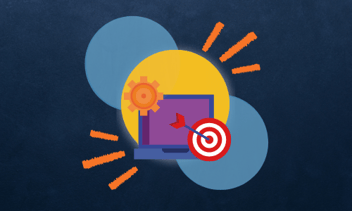
Once you’ve built your buyer personas and understand who you’re trying to reach with your content, you can tailor your content to target them more directly. But each buyer’s journey can take a different path: some journeys are quick, impulsive decisions, while others are carefully considered, long-deliberated processes. Developing models of each buyer’s journey can help you create content that's timed to best resonate with your personas along the way.
What Is the “Buyer’s Journey”?
The basic “buyer’s journey” model describes three stages of the active research process buyers go through before making a purchase: the awareness stage, the consideration stage, and the decision stage. In the “awareness” stage, your potential customer has symptoms of a problem or need and begins doing research to understand, frame, and give a name to the problem. Next, in the “consideration” stage, priorities shift to learning about the available choices to solve the problem or fill the need. Finally, in the “decision” stage, the buyer chooses a specific product, strategy, or purchase as a solution.
You can use the buyer’s journey model to evaluate what information your potential buyers need at each step of the process and what can help them advance to the next level. This insight can guide you in creating valuable content tailored to each buyer persona. As buyers research their needs and purchase options, they will ideally find content from your brand that answers their questions and moves them to the next stage of the process. Buyers' search queries bring them to your brand organically (rather than through paid advertising), so optimizing your content for these searches (SEO) can yield real results. However, just as your buyer personas are different, each buyer’s journey is different. Understanding how individual journeys differ can provide even more guidance in tailoring content to your prospective customers at important points in their reserach process.
All Buyers’ Journeys Are Not the Same
The general buyer’s journey model is a good start, but to get an idea of how it can be improved to better guide your content, think about the different kinds of purchases you make. The research, consideration, and decision-making processes can significantly different. For example,
- Some of your purchases are necessary, repeating, and somewhat insignificant, e.g., toilet paper, groceries, or clothing basics.
- Others are “impulse buys,” like a new book, a pair of shoes, or a take-out dinner.
- Some are significant and have long-lasting effects, such as a new home, car, or educational program.
- Some must be made by coordinating more than one person or group of people, like choosing a large anniversary gift with your siblings for your parents or deciding on a internet provider for your company.
Although the steps of the buyer’s journey will be similar in each case, each kind of purchase has different important factors. Therefore, the kind of content you should create for each kind of journey will differ.
If you’re selling a new soft drink, for example,
you might focus on content that inspires an impulsive purchase by creating a need in the awareness stage (“Aren’t you thirsty right now? Grab a Shazam cola!”) as well as content that targets repeating customers intending to purchase cola who are already in the consideration stage (“Shazam outperforms Peppy Cola in taste tests 2-1…switch today!”). Although your various buyer personas may be inspired to purchase for different reasons (price, taste, “cool” factor, nutrition, etc.), the stages of this buyer’s journey are pretty brief. Thirst is a basic need, and the long-term consequences of buying this inexpensive product once are insignificant, so a quick decision is likely. As a result, your content should focus on attracting and inspiring each of your target personas. Once you’ve given each of those customers a positive experience, you can target content to create a loyalty loop (“Collect Shazam points and win a trip to Shazaland!”), convert first-time buyers into repeat customers, and turn them into brand ambassadors.
On other journeys, like purchasing a car,
attraction isn’t enough because impulse buys are unlikely. You must create significant, substantial content targeting your personas during each stage that helps to differentiate your company and convince buyers to consider and choose your product. Your content should offer different satisfying answers to each of your personas at different points along the way. If you’re selling a mid-size economy car, for example, a young environmentalist may be interested in reading a marketing eBook about why she should purchase a new car at all and then listening to a podcast about your new, greener fuel system; a middle-aged parent might be interested in online video content showing all the options that make the vehicle comfortable for long roadtrips with the kids. You might need to target your content to multiple personas with different priorities (value, comfort, style, etc.) who may be making the decision together. Recognizing that this buyer’s journey may be one that takes weeks, months, or even years in some cases, and having content that patiently supports that ongoing process, from awareness to decision, is crucial to converting leads into sales.
Create Better Content by Understanding a Buyer’s Motivations at Every Step
Creating content that resonates with your potential buyers depends on understanding your buyer personas and recognizing what kind of journey they are on. How long will they spend on each step, and what kind of information will be most helpful to move them forward? Which content marketing styles do your prospects prefer at each step? Customizing your content to satisfy different personas at each stage of the journey will help you effectively target the audience you want and nurture them into customers.
If you need help building buyer personas, mapping buyer’s journeys, and creating perfectly tailored content that your audience will love every step of the way, call Blue Frog Marketing. We can help your business identify its audience, attract and engage potential customers, and convert them into leads and sales. Click the link below to contact us and get started today!
Blue Frog Marketing is based in Des Moines, Iowa, and provides comprehensive, cutting-edge online marketing as well as print and graphic design services for clients across the U.S. and beyond.



